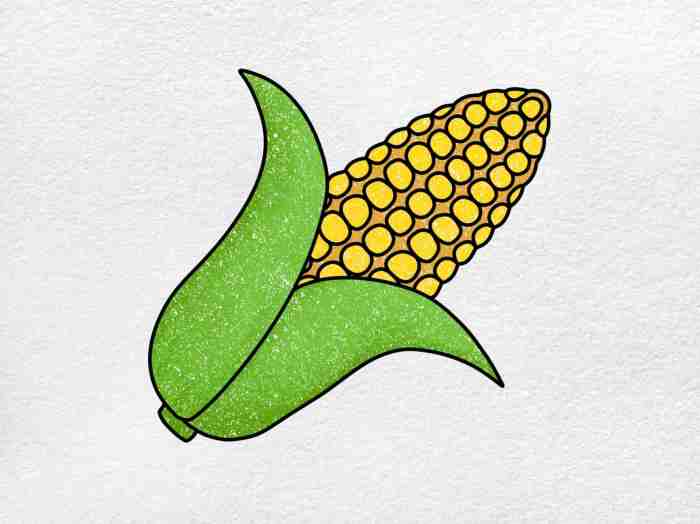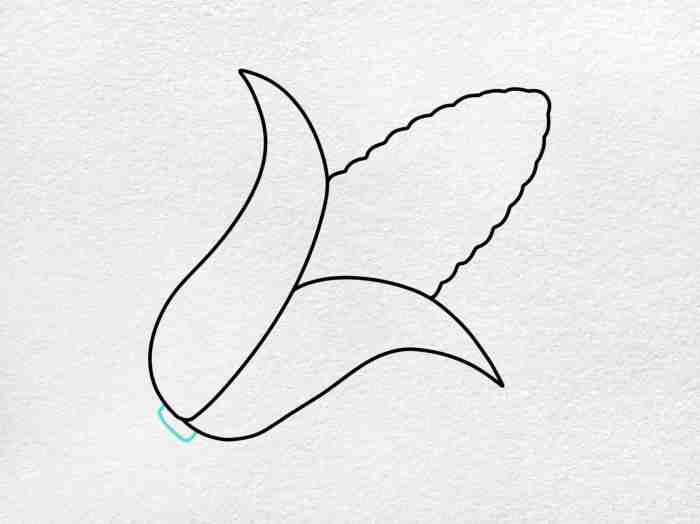Easy Cornstarch Drawing Techniques

Drawing of cornstarch easy – Cornstarch, a readily available kitchen staple, offers a surprisingly versatile medium for artistic expression. Its malleability, coupled with its ease of cleanup, makes it an ideal material for both novice and experienced artists exploring unconventional drawing techniques. The following techniques demonstrate the diverse range of effects achievable by manipulating the simple cornstarch and water mixture.
Cornstarch-Water Ratio and Line Variation
The key to controlling the outcome of cornstarch drawing lies in the precise ratio of cornstarch to water. A thicker mixture, achieved with a higher concentration of cornstarch, will produce bold, opaque lines. Conversely, a thinner mixture, with a higher water content, results in delicate, translucent lines. Experimentation is key; start with a 1:1 ratio and adjust according to your desired effect.
For smooth, even lines, a smooth, consistent application is crucial. Avoid jerky movements, instead using slow, deliberate strokes. Thick lines are easily achieved by increasing the amount of cornstarch in the mixture and applying it with a broader instrument, such as a brush or even a spatula. Fine details require a thinner mixture and a more precise application tool, such as a toothpick or a fine-tipped brush.
Texture Manipulation Through Additives
Introducing additives to the cornstarch-water base opens up a world of textural possibilities. Adding a small amount of salt to the mixture, for example, creates a subtly grainy texture, ideal for representing rough surfaces or adding visual interest to backgrounds. Similarly, incorporating fine sand or colored pigments can create unique effects. The addition of a binding agent, such as a small amount of PVA glue, can increase the durability of the drawing, preventing cracking or smudging.
The specific additive and its quantity will significantly impact the final texture and should be experimented with to achieve desired results.
Controlling Flow and Consistency
Maintaining a consistent flow and texture throughout the drawing process requires careful management of the cornstarch mixture. It is advisable to prepare only a small amount of mixture at a time to prevent it from drying out. Cover the unused portion with a damp cloth to maintain its consistency. If the mixture becomes too thick, add a few drops of water at a time until it reaches the desired consistency.
Conversely, if it becomes too thin, add a small amount of cornstarch, mixing thoroughly to prevent lumps. Regular stirring is crucial to prevent settling and maintain a uniform texture. A smooth, consistent application is paramount for achieving predictable and desirable results. The ability to control the flow is directly correlated to the artist’s skill and practice.
Cornstarch Drawing Projects and Ideas

Cornstarch drawing, while seemingly simplistic, offers a surprisingly versatile medium for artistic expression. Its malleable nature allows for a range of techniques and projects, catering to diverse skill levels and creative visions. The following explores several project ideas, highlighting both the accessibility and the potential for sophisticated results. This is not a comprehensive list, but rather a starting point for exploring the possibilities inherent in this inexpensive and readily available material.
Yo, so drawing with cornstarch is super chill, right? It’s all about those easy, breezy lines. Think of it like a stepping stone to more complex stuff, like nailing an awesome drawing – check out this tutorial for an easy drawing of a pangolin if you wanna level up your skills. Then, you can totally rock those cornstarch masterpieces, adding all sorts of rad details!
Simple Cornstarch Drawing Projects for Beginners
The following projects are designed to be easily replicated, requiring minimal materials and skill. They serve as excellent introductions to the unique properties of cornstarch as an artistic medium. These projects are ideal for children or adults new to this technique, allowing for experimentation and creative exploration without the pressure of complex procedures.
- Simple Shapes: Create basic shapes like circles, squares, and triangles using various thicknesses of the cornstarch mixture to observe the resulting texture variations.
- Textured Backgrounds: Apply the cornstarch mixture in a dabbing motion to create a textured background for other artwork, like watercolor paintings or collage elements.
- Leaf Rubbings: Place leaves under a sheet of paper and rub the cornstarch mixture over the paper to create leaf prints. Experiment with different types of leaves for varying textures and patterns.
- Simple Landscapes: Create a basic landscape using varying shades of cornstarch mixture to depict a sky, hills, and trees. This project focuses on basic color blending and layering techniques.
- Abstract Designs: Experiment with dripping, splattering, and smearing the cornstarch mixture to create abstract designs. This encourages uninhibited creative expression.
Detailed Guide: Creating a Swirling Cornstarch Design
This project demonstrates a simple yet visually striking technique that utilizes the fluidity of the cornstarch mixture to create an organic, swirling pattern.
1. Preparation
Mix cornstarch with water to create a smooth, pourable consistency. Experiment with different water ratios to achieve desired thickness. Add food coloring for visual impact.
2. Surface Preparation
Secure a sheet of watercolor paper or heavy drawing paper to a flat surface.
3. Application
Using a spoon or a squeeze bottle, apply the cornstarch mixture to the center of the paper.
4. Swirling Motion
Slowly rotate the paper while continuously applying the cornstarch mixture, creating a swirling pattern. The resulting effect is a series of concentric circles, gradually fading in opacity towards the center. The speed of rotation and the amount of cornstarch applied will influence the final design.
5. Drying
Allow the artwork to air dry completely. The drying time will vary depending on the thickness of the applied mixture and environmental conditions. The final result is a unique, textured artwork with a captivating visual effect. The swirling pattern will exhibit subtle variations in color and opacity due to the uneven distribution of the cornstarch mixture.
Cornstarch Drawing Projects by Difficulty Level
This table organizes the previously mentioned projects based on their complexity, providing a clear progression for aspiring cornstarch artists.
| Project Name | Difficulty | Materials | Description |
|---|---|---|---|
| Simple Shapes | Beginner | Cornstarch, water, paper, food coloring (optional) | Creating basic shapes with varying mixture thicknesses. |
| Textured Backgrounds | Beginner | Cornstarch, water, paper, other art supplies (optional) | Dabbing cornstarch for textured backgrounds for other artwork. |
| Leaf Rubbings | Beginner | Cornstarch, water, paper, leaves | Creating leaf prints using cornstarch and leaves. |
| Swirling Design | Intermediate | Cornstarch, water, paper, food coloring (optional), squeeze bottle (optional) | Creating a swirling pattern by rotating the paper while applying the mixture. |
| Abstract Designs | Intermediate | Cornstarch, water, paper, food coloring (optional) | Experimenting with dripping, splattering, and smearing techniques. |
| Simple Landscapes | Intermediate | Cornstarch, water, paper, food coloring | Creating a basic landscape using color blending and layering. |
Troubleshooting Cornstarch Drawing Issues: Drawing Of Cornstarch Easy

Cornstarch drawing, while seemingly simple, presents unique challenges. The inherent properties of the medium—its delicate consistency and susceptibility to environmental factors—can lead to frustrating results if not properly managed. Understanding these challenges and implementing effective solutions is crucial for achieving successful and long-lasting artwork. This section will address common problems and offer practical solutions for a smoother creative process.
Uneven Consistency
Uneven consistency, characterized by areas of varying thickness or opacity in the drawing, is a frequent problem. This often stems from inconsistent mixing of the cornstarch and water solution. Insufficient mixing can leave clumps of cornstarch, resulting in thicker, less fluid areas. Conversely, excessive water can lead to thin, watery sections prone to smudging.To rectify this, meticulous mixing is paramount.
A thorough, slow stirring process, preferably with a whisk or electric mixer at low speed, is recommended. The ideal consistency should resemble thick cream, neither too thin nor too thick. Adjusting the water content gradually, adding small amounts at a time, allows for precise control over the final consistency. Testing the mixture on a scrap piece of paper before starting the drawing ensures a uniform application.
Smudging and Transfer, Drawing of cornstarch easy
The inherent softness of cornstarch drawings makes them susceptible to smudging and accidental transfer. This is particularly problematic when handling the artwork or when the drawing is exposed to moisture or pressure. Fresh drawings are especially vulnerable as the cornstarch hasn’t fully set.Preventing smudging requires careful handling and appropriate drying techniques. Allow the drawings to dry completely in a dust-free, undisturbed environment.
Using a low-heat setting on a hair dryer or fan can expedite the drying process while minimizing the risk of damaging the artwork. Once dry, a thin layer of fixative spray, specifically designed for delicate artwork, can further enhance the drawing’s resistance to smudging and transfer. However, be mindful of the type of fixative, as some can alter the appearance of the drawing.
Drying Too Quickly
Rapid drying can lead to cracking and a less smooth appearance in cornstarch drawings. This often happens in dry, warm environments or when the cornstarch mixture is applied too thinly. The quick evaporation of water prevents the cornstarch from settling evenly, causing a fragile surface prone to damage.To avoid this, control the drying environment. Work in a room with moderate humidity and temperature.
Apply the cornstarch mixture in a consistent, moderate layer to allow for even drying. Avoid using fans or heaters directly on the artwork. A slower drying process allows the cornstarch to bond properly, resulting in a more durable and aesthetically pleasing drawing. A thin, even layer of plastic wrap, loosely placed over the drawing, can help regulate the drying rate without trapping moisture.
Preservation and Storage of Finished Drawings
The preservation of cornstarch drawings requires careful consideration. Their delicate nature demands protection from moisture, dust, and physical damage. Once completely dry, the drawings should be stored in a cool, dry, and dark place. A protective sleeve, such as an acid-free archival sleeve, provides a barrier against dust and minor handling. Avoid storing the drawings in direct sunlight or in humid environments, as this can cause deterioration.
For long-term preservation, consider framing the artwork under glass, using acid-free matting and backing boards to ensure its longevity.
FAQ
Can I use any type of cornstarch?
While most cornstarches work, refined cornstarch generally provides better results due to its smoother consistency. Avoid modified cornstarches as they might have different properties.
How long do cornstarch drawings take to dry?
Drying time depends on the thickness of the application and the surrounding humidity. Expect anywhere from a few minutes to a couple of hours for complete drying.
Can I preserve my cornstarch drawings?
Once completely dry, you can lightly spray your artwork with a fixative to help prevent smudging and increase longevity. Store in a dry, cool place to prevent moisture damage.
What happens if my cornstarch mixture is too thick or too thin?
Too thick? Add a little water. Too thin? Add a bit more cornstarch until you reach your desired consistency. Experiment to find your perfect blend!
